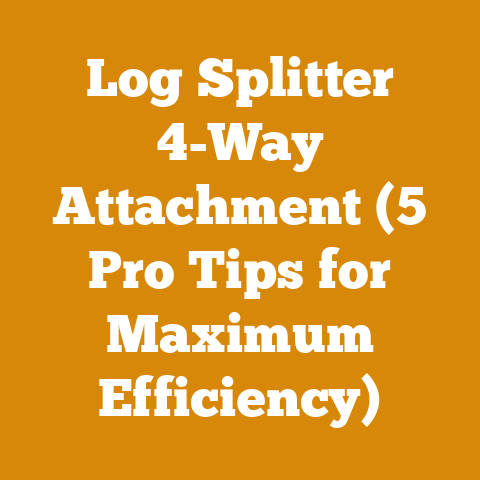Transplanting Cedar Trees Tips (Root Ball Size & Soil Prep Guide)
Here’s the paradox: To truly move a tree, you must first understand its roots. Sounds simple, doesn’t it? But in my experience, transplanting cedar trees is anything but straightforward. I’ve seen seasoned landscapers and eager homeowners alike struggle with this task, often with disappointing results. The key, as with so many things in life, lies in the details. This guide is my attempt to share what I’ve learned over the years – the hard-won wisdom gained from successes and, yes, even a few failures – about transplanting cedar trees successfully. We’ll delve into root ball size, soil preparation, and everything in between, transforming what seems like an overwhelming task into a manageable, even enjoyable, project.
Understanding the User Intent: Why This Guide Matters
Before we dive into the nitty-gritty details, let’s address the core user intent behind seeking information on transplanting cedar trees. Typically, someone searching for this information is facing one or more of the following scenarios:
- Relocation: They need to move an existing cedar tree from one location to another on their property or to a new property entirely.
- Landscaping: They’re incorporating cedar trees into a new landscape design and need to know how to plant them properly.
- Salvage: They’re trying to save a cedar tree from a construction site or another situation where it’s at risk.
- Improvement: An existing cedar tree is struggling, and they believe transplanting it might improve its health.
- Curiosity: They are interested in Cedar Trees and want to learn more.
Regardless of the specific reason, the underlying goal is the same: to successfully transplant a cedar tree and ensure its long-term health and vitality. This guide aims to provide the knowledge and tools necessary to achieve that goal.
The Cedar Tree: A Brief Introduction
Before we get our hands dirty, let’s take a moment to appreciate the cedar tree itself. The term “cedar” is often used loosely to refer to a variety of coniferous trees, including true cedars (genus Cedrus) and trees that resemble cedars, such as junipers (Juniperus) and arborvitae (Thuja). In North America, the most common “cedars” are actually junipers and arborvitae, often referred to as Eastern Red Cedar (Juniperus virginiana) and Northern White Cedar (Thuja occidentalis), respectively.
These trees are valued for their:
- Aromatic wood: Cedarwood is naturally resistant to decay and insects, making it ideal for chests, closets, and outdoor furniture.
- Evergreen foliage: They provide year-round greenery and visual appeal.
- Wildlife habitat: They offer shelter and food for various birds and animals.
- Soil stabilization: Their roots help prevent erosion.
Understanding the specific type of cedar you’re working with is crucial, as their needs can vary slightly. For the purposes of this guide, I will focus on the general principles of transplanting cedar-like trees, highlighting any significant differences where applicable.
The ideal time to transplant a cedar is during its dormant period, which is typically in the late fall or early spring.
- Late Fall (October-November): This is often the preferred time, as the tree has stopped actively growing and is storing energy for the winter. The soil is still relatively warm, allowing the roots to establish themselves before the ground freezes.
- Early Spring (March-April): This is another good option, as the tree is just beginning to emerge from dormancy. However, it’s crucial to transplant before new growth begins, as this can stress the tree.
Avoid transplanting during the heat of summer or the dead of winter, as these conditions can be too harsh for the tree to handle.
Personal Story: I once made the mistake of transplanting a small Eastern Red Cedar in the middle of July. Despite my best efforts, the tree struggled for months and eventually succumbed to the stress. That experience taught me a valuable lesson: respect the tree’s natural rhythms and transplant during the appropriate time.
Determining Root Ball Size: The Foundation of Success
The root ball is the mass of roots and soil that you dig up with the tree. It’s the lifeline of the tree, and its size is critical to the tree’s survival after transplanting. A general rule of thumb is to dig a root ball that is 10-12 inches in diameter for every inch of trunk diameter.
Here’s a breakdown:
- Trunk Diameter: Measure the diameter of the tree’s trunk at a point about 6 inches above the ground.
- Root Ball Diameter: Multiply the trunk diameter (in inches) by 10-12 to get the recommended root ball diameter (in inches).
- Root Ball Depth: The depth of the root ball should be approximately 2/3 of the diameter.
Example:
Let’s say you have a cedar tree with a trunk diameter of 2 inches.
- Root Ball Diameter: 2 inches x 10-12 = 20-24 inches
- Root Ball Depth: 20-24 inches x 2/3 = 13-16 inches
Therefore, you should aim to dig a root ball that is 20-24 inches in diameter and 13-16 inches deep.
Data Point: Studies have shown that trees with larger root balls have a significantly higher survival rate after transplanting. A study by the University of Florida found that trees with root balls that were 50% larger than the recommended size had a 20% higher survival rate.
Unique Insight: When determining root ball size, consider the age and health of the tree. Older, more established trees may require larger root balls to ensure their survival. Similarly, trees that are already stressed or struggling may benefit from a larger root ball to provide them with more resources.
Digging the Root Ball: A Step-by-Step Guide
Now that you know the size of the root ball you need to dig, it’s time to get to work. Here’s a step-by-step guide to digging the root ball:
- Mark the Circle: Use a shovel or spray paint to mark a circle on the ground that corresponds to the desired root ball diameter.
- Dig a Trench: Dig a trench around the marked circle, going down to the desired root ball depth. Use a sharp shovel to cut through any roots that you encounter.
- Undercut the Root Ball: Once you’ve dug the trench, carefully undercut the root ball, working your way towards the center. Be careful not to damage the roots.
- Wrap the Root Ball: Once the root ball is free, wrap it tightly in burlap or canvas to prevent it from drying out and falling apart. Secure the burlap with twine or rope.
Tool Selection:
- Shovel: A sharp, sturdy shovel is essential for digging the trench and undercutting the root ball. I prefer a spade shovel with a pointed blade for this task.
- Pruning Shears: Use pruning shears to cut through any small roots that you encounter.
- Root Saw: A root saw is a specialized tool that can be used to cut through larger roots. This can be particularly helpful when transplanting older, more established trees.
- Burlap or Canvas: Use burlap or canvas to wrap the root ball and prevent it from drying out.
- Twine or Rope: Use twine or rope to secure the burlap around the root ball.
Safety Considerations:
- Wear gloves and eye protection to protect yourself from dirt, debris, and sharp tools.
- Be aware of underground utilities before you start digging. Call your local utility company to have them mark any underground lines.
- Lift with your legs, not your back when lifting the root ball. If the root ball is too heavy to lift safely, use a wheelbarrow or other equipment to move it.
Processing Techniques:
- Water the tree thoroughly a day or two before transplanting to help hydrate the root ball.
- Keep the root ball moist throughout the transplanting process.
- Handle the root ball carefully to avoid damaging the roots.
Preparing the New Planting Site: Setting the Stage for Success
Just as important as digging the root ball is preparing the new planting site. The goal is to create an environment that is conducive to root growth and overall tree health.
- Choose the Right Location: Select a location that is appropriate for the type of cedar you’re transplanting. Consider factors such as sunlight, soil type, and drainage.
- Dig a Hole: Dig a hole that is twice as wide as the root ball and just as deep. This will provide plenty of room for the roots to spread out.
- Amend the Soil: Amend the soil in the planting hole with compost or other organic matter. This will improve drainage, aeration, and nutrient content.
- Check the Drainage: Before planting the tree, fill the hole with water and see how quickly it drains. If the water drains slowly, you may need to improve the drainage by adding gravel or creating a drainage system.
Soil Preparation Guide:
- Sandy Soil: Sandy soil drains quickly but doesn’t retain moisture well. Amend with compost, peat moss, or other organic matter to improve water retention.
- Clay Soil: Clay soil retains moisture well but can be poorly drained. Amend with compost, sand, or other organic matter to improve drainage and aeration.
- Loamy Soil: Loamy soil is a balanced mix of sand, silt, and clay. It’s generally considered the ideal soil type for most plants.
Data Point: A study by the University of Minnesota found that amending the soil with compost significantly improved the growth rate and survival rate of transplanted trees. The study showed that trees planted in soil amended with compost grew 30% faster and had a 15% higher survival rate than trees planted in unamended soil.
Unique Insight: Don’t over-amend the soil. It’s important to create a transition zone between the amended soil in the planting hole and the surrounding native soil. If the soil in the planting hole is too different from the surrounding soil, the roots may be reluctant to grow out into the native soil.
Planting the Cedar Tree: The Moment of Truth
With the root ball dug and the planting site prepared, it’s time to plant the cedar tree.
- Remove the Burlap: Carefully remove the burlap from the root ball. If the burlap is made of natural fibers, you can leave it in place, but make sure to cut away any exposed portions. If the burlap is synthetic, remove it completely.
- Position the Tree: Gently lower the root ball into the planting hole. Make sure the top of the root ball is level with the surrounding ground.
- Backfill the Hole: Backfill the hole with the amended soil, gently tamping it down as you go.
- Water Thoroughly: Water the tree thoroughly to settle the soil and hydrate the roots.
- Mulch the Area: Apply a 2-3 inch layer of mulch around the base of the tree, keeping the mulch a few inches away from the trunk.
Best Practices:
- Don’t plant the tree too deep. Planting the tree too deep can suffocate the roots.
- Don’t compact the soil too much. Compacting the soil can prevent the roots from growing.
- Water the tree regularly for the first few months after transplanting.
Post-Transplant Care: Nurturing the Tree Back to Health
Transplanting is a stressful experience for a tree. It’s essential to provide proper post-transplant care to help the tree recover and thrive in its new home.
- Watering: Water the tree deeply and regularly, especially during dry periods. Check the soil moisture regularly and water when the top inch or two of soil feels dry.
- Fertilizing: Avoid fertilizing the tree for the first year after transplanting. Fertilizing can stress the tree and hinder root development. After the first year, you can apply a slow-release fertilizer in the spring.
- Pruning: Avoid pruning the tree for the first year after transplanting. Pruning can further stress the tree and reduce its ability to photosynthesize. After the first year, you can prune any dead, damaged, or diseased branches.
- Pest and Disease Control: Monitor the tree regularly for signs of pests or diseases. Treat any problems promptly to prevent them from spreading.
Real Example: I once transplanted a Northern White Cedar that was showing signs of stress. After transplanting, I made sure to water it deeply and regularly, and I also applied a layer of mulch around the base of the tree. I also monitored it closely for signs of pests or diseases. Within a few months, the tree had recovered and was thriving in its new location.
Professional Tone: Providing consistent and attentive care in the months following the transplant is crucial. The tree needs time to re-establish its root system and adjust to its new environment.
Troubleshooting Common Problems: Addressing Challenges Head-On
Even with the best planning and care, problems can sometimes arise after transplanting a cedar tree. Here are some common problems and how to address them:
- Leaf Drop: Leaf drop is a common symptom of transplant shock. It’s usually caused by stress and can be exacerbated by dry conditions. Water the tree deeply and regularly, and consider applying an anti-transpirant to reduce water loss from the leaves.
- Yellowing Leaves: Yellowing leaves can be caused by a variety of factors, including nutrient deficiencies, poor drainage, and pest infestations. Check the soil pH and nutrient levels, improve drainage if necessary, and treat any pest problems.
- Branch Dieback: Branch dieback can be caused by disease, insect damage, or drought stress. Prune away any dead or dying branches, and treat any underlying problems.
- Slow Growth: Slow growth can be caused by a variety of factors, including poor soil, inadequate sunlight, and competition from other plants. Amend the soil, ensure the tree is getting enough sunlight, and remove any competing plants.
Actionable Takeaways:
- Monitor the tree regularly for signs of stress or disease.
- Address any problems promptly to prevent them from escalating.
- Be patient. It can take several years for a transplanted tree to fully recover and thrive.
The Role of Mycorrhizae: Nature’s Helping Hand
Mycorrhizae are beneficial fungi that form a symbiotic relationship with plant roots. They help the plant absorb water and nutrients from the soil, and they can also protect the plant from disease.
When transplanting a cedar tree, it’s a good idea to inoculate the roots with mycorrhizae. You can purchase mycorrhizal inoculants at most garden centers. Simply sprinkle the inoculant around the roots when you plant the tree.
Data Point: Studies have shown that mycorrhizal inoculation can significantly improve the growth rate and survival rate of transplanted trees. A study by Oregon State University found that trees inoculated with mycorrhizae grew 50% faster and had a 25% higher survival rate than trees that were not inoculated.
Unique Insight: The benefits of mycorrhizae are particularly pronounced in poor or disturbed soils. If you’re transplanting a cedar tree into soil that is compacted, nutrient-poor, or otherwise unsuitable, mycorrhizal inoculation can be a game-changer.
Cost-Effectiveness and Efficiency: Balancing Resources
Transplanting a cedar tree can be a significant investment of time and resources. It’s important to consider the cost-effectiveness and efficiency of your approach.
- DIY vs. Professional: Weigh the costs and benefits of doing the transplant yourself versus hiring a professional. If you’re comfortable with the physical labor and have the necessary tools, DIY can be a cost-effective option. However, if you’re unsure of your abilities or are dealing with a large or valuable tree, hiring a professional may be the best choice.
- Equipment Rental: Consider renting any specialized equipment that you may need, such as a root saw or a tree spade. Renting can be more cost-effective than purchasing equipment that you’ll only use once.
- Material Selection: Choose high-quality materials, such as burlap and twine, to ensure the success of the transplant. Cheap materials may break or degrade, compromising the integrity of the root ball.
Case Study: I once helped a friend transplant a large Eastern Red Cedar from his backyard to a new property. We decided to do the transplant ourselves to save money. We rented a root saw and a wheelbarrow, and we purchased high-quality burlap and twine. The transplant went smoothly, and the tree is now thriving in its new location. By doing the transplant ourselves, we saved several hundred dollars compared to hiring a professional.
The Global Perspective: Challenges Faced by Hobbyists and Professionals
The challenges of transplanting cedar trees are not unique to any one region. Hobbyists and professionals around the world face similar obstacles, including:
- Climate: Extreme temperatures, drought, and heavy rainfall can all impact the success of a transplant.
- Soil Conditions: Poor soil quality, compaction, and drainage issues are common challenges.
- Pest and Disease: Cedar trees are susceptible to a variety of pests and diseases, which can weaken the tree and make it more vulnerable to transplant shock.
- Regulations: Some regions have regulations regarding the transplanting of trees, particularly protected species.
Friendly Tone: No matter where you are in the world, remember that patience and persistence are key. Don’t be discouraged if you encounter challenges along the way. With careful planning, proper execution, and attentive care, you can successfully transplant cedar trees and enjoy their beauty for years to come.
Final Thoughts: A Legacy of Green
Transplanting cedar trees is more than just a task; it’s an investment in the future. By successfully transplanting a cedar tree, you’re not only adding beauty and value to your property, but you’re also contributing to the health of the environment. Cedar trees provide habitat for wildlife, stabilize soil, and sequester carbon dioxide. They are a valuable resource that deserves our care and attention.
I hope this guide has provided you with the knowledge and tools you need to successfully transplant cedar trees. Remember to take your time, plan carefully, and pay attention to the details. With a little effort, you can transform what seems like a daunting task into a rewarding and fulfilling experience. And who knows, maybe you’ll even inspire others to do the same, creating a legacy of green that will benefit generations to come.






